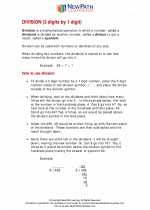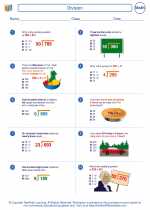Division Study Guide
What is Division?
Division is the process of splitting a number into equal parts. It is the opposite of multiplication. When you divide a number by another number, you are finding out how many times the second number can fit into the first number.
Division Notation
Division is often represented using the division symbol (÷) or by using a fraction bar. For example, 10 ÷ 2 or 10/2 both represent the division of 10 by 2.
Key Terms in Division
- Dividend: The number being divided
- Divisor: The number by which the dividend is being divided
- Quotient: The result of the division
- Remainder: The amount left over when the dividend cannot be divided equally by the divisor
Division Example
Let's look at an example: 15 ÷ 3.
In this case, 15 is the dividend and 3 is the divisor. When we divide 15 by 3, we get a quotient of 5 because 3 can fit into 15 five times with no remainder.
Division Properties
Just like addition, subtraction, and multiplication, division has its own set of properties. Some of the key properties of division include the commutative property, associative property, and distributive property.
Division Techniques
There are various techniques for division, including long division, short division, and using a calculator. Each technique has its own advantages and is useful in different situations.
Division Practice
Now that you have learned about division, it's important to practice solving division problems to solidify your understanding. Try solving the following division problems:
- 24 ÷ 4
- 36 ÷ 6
- 45 ÷ 9
Remember to check your answers and understand any mistakes you might make along the way.
.◂Math Worksheets and Study Guides Sixth Grade. Division

 Worksheet/Answer key
Worksheet/Answer key
 Worksheet/Answer key
Worksheet/Answer key
 Worksheet/Answer key
Worksheet/Answer key
